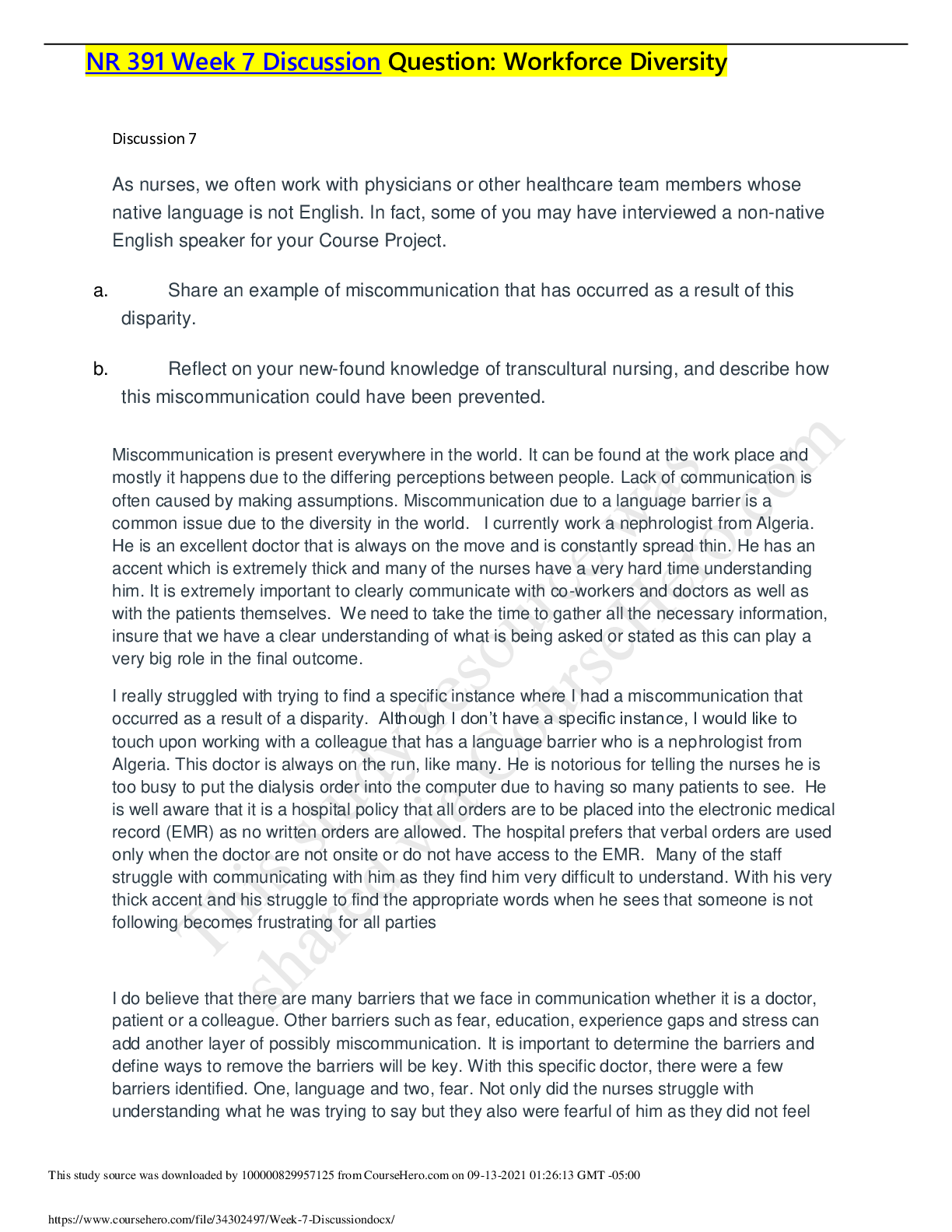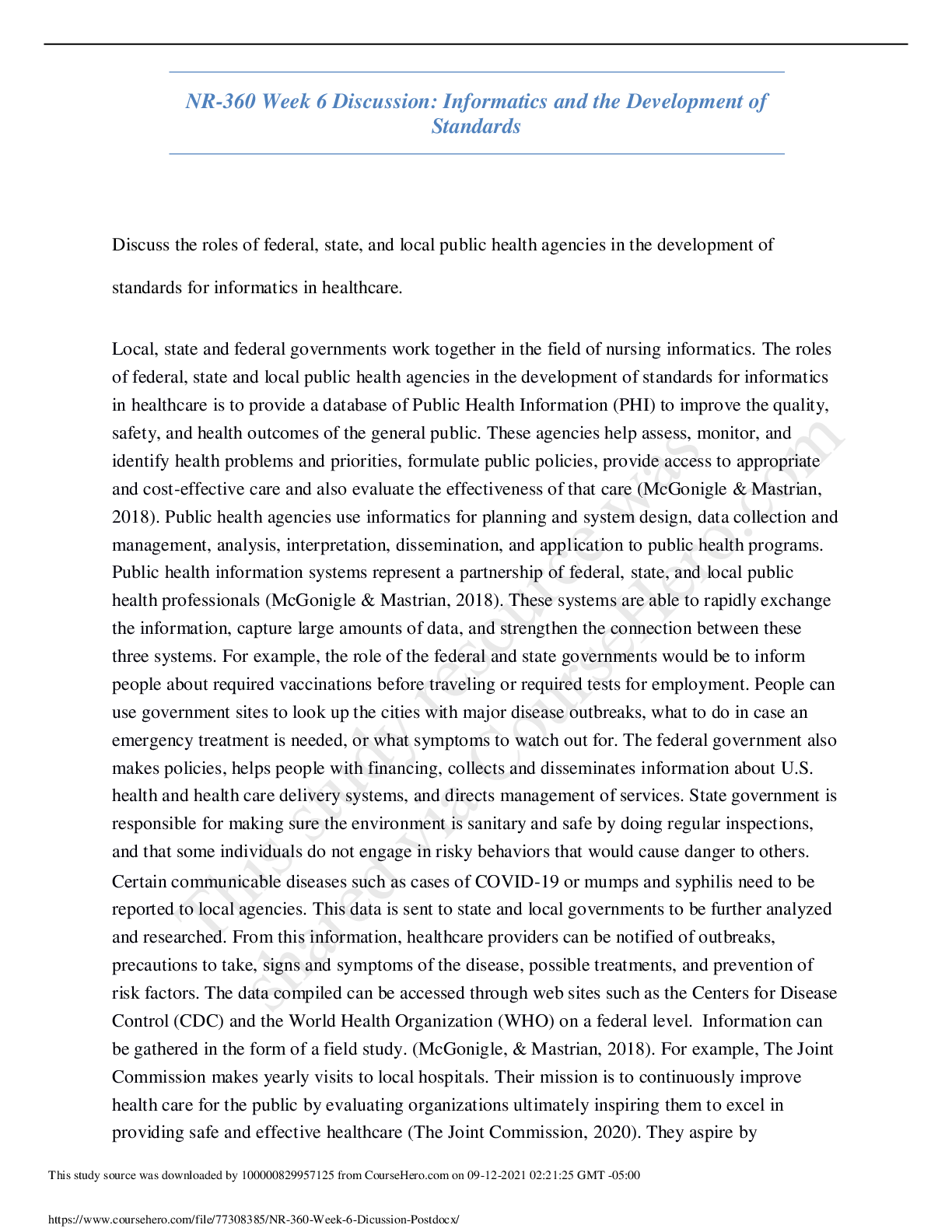*NURSING > DISCUSSION POST > SCI-228 Week 1 Discussion: The Digestive System | Already Graded A+ (All)
SCI-228 Week 1 Discussion: The Digestive System | Already Graded A+
Document Content and Description Below
SCI-228 Week 1 Discussion: The Digestive System Week 1 discussion Class -Please define the following and identify their location along the digestive tract! Esophageal sphincter Gastroesophageal... sphincter (sometimes referred to as the lower esophageal sphincter) Pyloric sphincter Ileo-cecal valve Why are these important along the route of the digestive tract? Esophageal sphincter- In upper esophageal sphincter. A sphincter that keeps the opening between the pharynx and the proximal esophagus closed, except during swallowing. It is maintained by the cricopharyngeal muscle. Gastroesophageal sphincter- a ring of smooth muscle fibers connecting the esophageal and stomach. Also called lower esophageal sphincter. Pyloric sphincter- The pyloric sphincter is a band of smooth muscle at the junction between the pylorus of the stomach and the duodenum of the small intestine. It plays an important role in digestion, where it acts as a valve to controls the flow of partially digested food from the stomach to the small intestine ileocecal valve - the valve formed by two folds of mucous membrane at the opening of the ileum into the large intestine—called also Bauhin's valve, ileocolic valve, valvula coli. • Imagine yourself eating a ham and a sandwich which steps take place with regard to digest the sandwich? a) Make sure that the students can distinguish between mechanical and chemical digestion. I would say that while eating sandwich all system of body is involved in preparing and eating process except reproductive system. I believe that the journey of a sandwich and a ham (or any piece of food) takes as it makes its way through the digestive tract. I will say that first; it all starts in our head. For example, in front of my is a turkey and a cheese sandwich with lettuce, onion, red bell, pepper, mustard and mayonnaise on multi-grain bread. If I really want that sandwich, I must have to notice that i am salivating. The hungrier I am and the more I will salivate. That’s because digestion actually begins in the brain. This is the cephalic phase of digestion, which is stimulated by the parasympathetic nervous system. When I see and smell food and even start thinking about eating, the brain readies the digestive tract for nourishment. This anticipation stimulates the secretion of saliva in the mouth and gastric juices in the stomach. a) Digestion in the mouth and distinguish between mechanical and chemical digestion. Once if I take a bite of sandwich I have initiated mechanical digestion. This chewing reduces the size of the food particles and mixes them with saliva for easier swallowing. Before my food passes from the mouth and down to esophagus, salivary amylase, an enzyme in saliva, begins to digest the starch in my bread. That is the start of chemical digestion. The mass of chewed sandwich is called a bolus. I voluntarily swallow it, but the rest of the digestion-absorption process is involuntary. The passage of the bolus through the esophagus to the stomach occurs by peristalsis, a series of wave-like muscle contractions. Reference Food and our Digestive Tract.(n.d.). Retrieved from, http://www.innerbody.com/nutrtition/food-and-our-digestive-tract b) What does HCL play with regard to protein digestion and bacteria? Digestion in the stomach As the bolus approaches the stomach, a ring-like muscle called the lower esophageal sphincter relaxes, allowing the chewed food to enter. Peristalsis mixes the bolus with gastric secretions containing hydrochloric acid (HCL), hormones and digestive enzymes to produces a thick slurry called chyme. Hydrochloric acid is so strong that it could dissolve metal. It doesn’t eat away at the stomach mucosa (lining) because I have cells that also secrete mucus to protect my stomach wall. The acid kills much of the microorganisms that piggyback on my food, and in his way the acid has prevented me from frequently becoming sick. To aid digestion, HCL denatures or unfolds proteins, making them more available to attack by digestive enzymes. The digestive enzymes pepsin begins to breakdown the protein in my sandwich (largely the meat and cheese with smaller amounts in the bread and vegetables). Gastric lipase begins to digest the fats present in my cheese and mayonnaise, but doesn’t so only minimally. Digestion of the starch in my bread does not occur in the stomach became inactive in the presence of stomach acid. Reference Food and our Digestive Tract.(n.d.). Retrieved from, http://www.innerbody.com/nutrtition/food-and-our-digestive-tract c) What are the role of the small and large intestines? The small intestine is the part of the intestines where 90% of the digestion and absorption of food occurs, the other 10% taking place in the stomach and large intestine. The main function (role) of the small intestine is absorption of nutrients and mineral from food. Peristalsis pushes food waste, fiber (from your bread and vegetables) and any foreign materials through the small and large intestines. More water and salts are absorbed from the large intestine. As the contents move downward, the feces - consisting of water, fiber, intestinal secretions and dead bacteria - are formed and eventually pushed through the anus. Reference Food and our Digestive Tract.(n.d.). Retrieved from, http://www.innerbody.com/nutrtition/food-and-our-digestive-tract 2 discussion what does food safety and technology have to do with me? a) Food spoilage. How and why does it occur? Food spoilage can be defined as a disagreeable change in a food’s normal state. Such changes are due to a number of reasons: air and oxygen, light, moisture, which foster the growth of microorganisms. Food spoilage and spoilage can occur when there are slight changes in relative humidity. Moisture can condense on the surface of a product and this can result in many common food defects. The molding of grain, soggy cereals, and the caking and lumping of dry products like powders and cake mixes can result from excessive moisture. Other defects such as mottling, crystallization and stickiness have also been observed. Moisture condensing on the surface of a food can also provide an environment for bacteria and molds grow and multiply. Physical defects such as cracking, splitting and crumbling occur when excessive moisture is lost from foods. References Food safety Education. (2016). Retrieved from http://www.foodsafetysite.com/educators/competencies/genral/spoilage/spg1.html b) What are four most important things when it comes to food safety? Food sickness is caused by bacteria, viruses and parasites which we sometimes group together and collectively call “germs”. They are so small that, most of the time, you can’t see, smell or taste them. If food safety practices are not followed harmful germs can grow or be transferred to other foods and make the food not safe to eat. Not all germs are bad; in fact, germs are naturally present on many foods.an example of good germs is the bacteria that turn milk into yogurt. The four important steps to prevent food sickness are clean, separate, cook and chill. c) Define organic foods and the process involved with becoming a certified organic farm. Organic food is produced without using most conventional pesticides; fertilizers made with synthetic ingredients is sewage sludge; bioengineering; or ionizing radiation. Organic certification is a certification process for producers of organic food and other organic agricultural products. In general, any business directly involved in food production can be certified, including seed suppliers, retailers and restaurants. There are different requirement in every country, but in generally involve a set of production standards for growing, storage, processing, packaging and shipping that include: 1) Avoidance of synthetic chemical inputs; 2) Avoidance of genetically modified seed; 3) Use of farmland that has free from prohibited chemical inputs for a number of years; 4) For livestock, adhering to specific requirements for feed, housing, and breeding; 5) Maintaining strict physical separation of organic products from non-certified products. References Organic certification. (2016). Wikipedia. Retrieved from https://en.m.wikipedia.org/wiki/organic_certification Moreover, certification is overseen by the government, and commercial use of the term organic is legally restricted. Its producers are also subject to the same agricultural, food safety and other government regulations that apply to non-certified producers. Week 2 1) Discussion Regular physical activity is one of the most important things you can do for your health. It can help: • Control your weight • Reduce your risk of cardiovascular disease • Reduce your risk for type 2 diabetes and metabolic syndrome • Reduce your risk of some cancers • Strengthen your bones and muscles • Improve your mental health and mood • Improve your ability to do daily activities and prevent falls, if you’re an older adult • Increase your chances of living longer Reference Physical Activity and Health. (2015). Retrieved July 12, 2016, from https://www.cdc.gov/physicalactivity/basics/pa-health/ 2) 13 Unexpected Benefits of Exercise Many people hit the gym or pound the pavement to improve cardiovascular health, build muscle, and of course, get a rockin’ body, but working out has above-the-neck benefits, too. For the past decade or so, scientists have pondered how exercising can boost brain function. Regardless of age or fitness level, studies show that making time for exercise provides some serious mental benefits. The unexpected ways that working out can benefit mental health, relationships, and lead to healthier and happier life overall are: 1) Reduce Stress 2) Boost happy chemicals 3) Improve self-confidence 4) Enjoy the great outdoors 5) Prevent cognitive decline 6) Alleviate anxiety 7) Boost brainpower 8) Sharpen memory 9) Help control addiction 10) Increase relaxation 11) Get more done 12) Tap into creativity 13) Inspire others Reference Breene, S, (2016). Greatist.N.p. “13 Unexpected benefits of exercise”. Retrieved from: http://greatist.com/fitness/13-awesome-mental-health-benefits-exercise 2) what are roles of carbohydrate? The role of carbohydrates is to provide energy, as they are the body's main source of fuel, needed for physical activity, brain function and operation of the organs. All the cells and tissues in your body need carbs, and they are also important for intestinal health and waste elimination. Week 2 discussion What is define of monosaccharide and give examples of it. Monosaccharide: - They are the simplest form of sugar and are usually colorless, water-soluble, and crystalline solids. Some monosaccharides have a sweet taste. Example of monosaccharides include glucose (dextrose), fructose (levulose) and galactose. Class - Please describe in detail a disaccharide and polysaccharide and provide examples! • Polysaccharides are polymers consisting of 20 to 107 monosaccharide units; they differ each other for the monosaccharides recurring in the structure, for the length and the degree of branching of chains or for the type of links between units. Whereas in the plant kingdom several types of polysaccharides are present, in vertebrates there are only a small number. Polysaccharides are defined omopolysaccharides if they contain only one type of monosaccharide as starch, glycogen and chitin; eteropolysaccharides, instead, contain two or more different kinds (e.g. hyaluronic acid). Disaccharides are formed when two monosaccharides are joined together and a molecule of water is removed, a process known as dehydration reaction. For example; milk sugar (lactose) is made from glucose and galactose whereas the sugar from sugar cane and sugar beets (sucrose) is made from glucose and fructose. Reference: Tuscany Diet. (2016). Carbohydrates: definition, classification, functions. Retrieved from http://www.tuscany-diet.net/carbohydrates/classification-functions/ What is the chemical formula for glucose? What is glucose? Why is glucose important in our body? Where does glucose come from? Please answer the following questions in great detail - looking forward to your posts! What is the chemical formula for glucose? Glucose contains six atoms of carbon, 12 atoms of hydrogen and six atoms of oxygen, giving it a chemical formula of C6H12O6. What is Glucose? A simple sugar that is an important energy source in living organisms and is a component of many carbohydrates. Why glucose is important in our body? The human body requires glucose for some of its most important functions. This simple sugar provides the energy needed to perform specialized such as digestion and cellular respiration. Problems with the amount of glucose in the blood result in serious complications that could lead to coma or even death if not corrected quickly. Where does glucose come from? The glucose in your blood comes from the carbohydrates in your food. Carbohydrates include sugar and starchy foods such as breads, pasta and rice. When you eat, the carbohydrates pass from your stomach into your small intestines. The carbohydrates are then broken down into glucose. Your body converts some of the glucose into a chemical called “glycogen”, which it stores in your liver and muscles. The remaining glucose will travel through the bloodstream to fuel your body’s cells and organs. This is the glucose you are measuring when you self-test your blood glucose level. Your brain and the cells in your body need the energy from glucose to function, so it is important that your blood glucose level is within a healthy range. References: Morgan, L. (2016). The importance of glucose. Retrieved from http://www.livestrong.com/article/133891-the-importance-glucose/ Lifescan.co.uk. (2016). LifeScan One Touch – Where does the glucose in your blood come from? Retrieved from https://www.lifescan.co.uk/knowledge/article/background/glucose Week 3 1) Lipids Fat is an essential part of your diet. It provides energy, absorbs certain nutrients and maintains your core body temperature. You need to consume fat every day to support these functions, but some types of fat are better for you than others. Good fats protect your heart and keep your body healthy, while bad fats increase your risk of disease and damage your heart. http://healthyeating.sfgate.com/three-functions-fat-body-3402.html 2) What role do proteins play in the body? Proteins are large, complex molecules that play many critical roles in the body. They do most of the work in cells and are required for the structure, function, and regulation of the body’s tissues and organs. Proteins are made up of hundreds or thousands of smaller units called amino acids, which are attached to one another in long chains. There are 20 different types of amino acids that can be combined to make a protein. The sequence of amino acids determines each protein’s unique 3dimensional structure and its specific function. https://ghr.nlm.nih.gov/primer/howgeneswork/protein What is the difference between HDL and LDL cholesterol - high density vs low density? Is one better for our health? How do we improve our cholesterol level? Cholesterol can't dissolve in the blood. It must be transported through your bloodstream by carriers called lipoproteins, which got their name because they’re made of fat (lipid) and proteins. The two types of lipoproteins that carry cholesterol to and from cells are low-density lipoprotein, or LDL, and high-density lipoprotein, or HDL. LDL cholesterol and HDL cholesterol, make up your total cholesterol count, which can be determined through a blood test. HDL (Good) Cholesterol HDL cholesterol is considered “good” cholesterol because it helps remove LDL cholesterol from the arteries. Experts believe HDL acts as a scavenger, carrying LDL cholesterol away from the arteries and back to the liver, where it is broken down and passed from the body. One-fourth to one-third of blood cholesterol is carried by HDL. A healthy level of HDL cholesterol may also protect against heart attack and stroke, while low levels of HDL cholesterol have been shown to increase the risk of heart disease. To improve cholesterol level, we need to eat Good or HDL cholesterol foods. Reference: Heart org. (2016). Good vs. Bad Cholesterol http://www.heart.org/HEARTORG/Conditions/Cholesterol/AboutCholesterol/Good-vs-Bad- Cholesterol_UCM_305561_Article.jsp#.V93DhZgrLIU What are the different types of triglycerides and which ones are considered healthier! Triglycerides are a type of lipid, or fat, found in your blood. When you eat, your body converts calories it does not use right away into triglycerides, which your body later stores in your fat cells. Between meals, hormones release triglycerides to provide you with energy. Regularly eating more calories than you burn may lead to high triglyceride levels in your blood. There are three different types of triglycerides. A triglyceride comprises three fatty acids attached to glycerol. The three types of fatty acids that compose triglycerides are saturated, monounsaturated and polyunsaturated fatty acids. From these three types of fatty acids come the three types of triglycerides, or fats; saturated, monounsaturated and polyunsaturated triglycerides. Reference: Benzaquen, J. (2013). Three types of Triglycerides http://www.livestrong.com/article/382856- three-types-of-triglycerides What is the difference between type 1 and type 2 diabetes? Symptoms usually start in childhood or young adulthood. People often seek medical help, because they are seriously ill from sudden symptoms of high blood sugar. The person may not have symptoms before diagnosis. Usually the disease is discovered in adulthood, but an increasing number of children are being diagnosed with the disease. Episodes of low blood sugar level (hypoglycemia) are common. There are no episodes of low blood sugar level, unless the person is taking insulin or certain diabetes medicines. It cannot be prevented. It can be prevented or delayed with a healthy lifestyle, including maintaining a healthy weight, eating sensibly, and exercising regularly. Reference: WebMD. Slideshow: 10 moves to help tame Diabetes. http://www.webmd.com/diabetes/ready- to-lower-16/slideshow-diabetes-strength-training What is the difference between type 1 and type 2 diabetes? Type 1 and type 2 diabetes in immune system? Symptoms of it? Type 1 In type 1 diabetes the body's immune system erroneously attacks its own beta cells, thereby destroying insulin production. Why does this happen? Scientists do not know, but it is likely that the condition develops gradually in a series of steps. Starting from a hereditary predisposition, various environmental influences (viral infections and poisoning are suspected) have to take effect, one after the other, before the self-destruction of insulin begins. With insulin treatment, a type 1 patient can live a perfectly normal life. Symptoms of type 1 diabetes • excessive thirst and dehydration • frequent urination • hunger, accompanied by weight loss • blurred vision • weakness, tiredness, or sleepiness • vomiting or nausea • sudden irritability Type 2 Diabetes Type 2 diabetes begins with insulin resistance. This means that the cells don't react to insulin the way they are supposed to. Normally, insulin binds to receptors on the cell surface. This activates the cell's glucose transporter molecules to form a doorway in the cell membrane so that glucose can enter the cell. However, when insulin resistance occurs, there's a reduced response to the insulin signals. Therefore, fewer doorways are formed and some glucose is locked out of the cells. Symptoms of type 2 diabetes • fatigue • excessive thirst • frequent urination • blurred vision • mood changes • a high rate of infections • slow healing process Reference “Facts About Diabetes And Insulin”. Nobelprize.org.N.p., 2016. Retrieved from: https://www.nobelprize.org/educational/medicine/insulin/diabetes-insulin.html Week 3 discussion Mufa and Pufa PUFA Omega-6- Fatty Acid Linoleic acid (LA), an omega-6 fat, is the most common PUFA in the diet. The appropriate intake of LA and other omega-6 fatty acids is controversial. LA is the precursor to arachidonic acid (AA), which can be metabolized into bioactive eicosanoids associated with inflammation and chronic disease. Reference: Ramsden, C. E. et al. "Use Of Dietary Linoleic Acid For Secondary Prevention Of Coronary Heart Disease And Death: Evaluation Of Recovered Data From The Sydney Diet Heart Study And Updated Meta-Analysis". BMJ 346.feb04 3 (2013): e8707-e8707. Web. 23 July 2016 MUFA Omega-9- Fatty Acid Omega-9 fatty acids can be synthesized in vivo; therefore, they aren’t essential to the diet. However, dietary omega-9 fats affect cardiovascular risk factors. When they replace saturated fatty acids in the diet, LDL cholesterol levels improve, HDL cholesterol levels remain stable, and insulin resistance improves.13 When replacing carbohydrate in the diet, omega-9 fats increase HDL cholesterol levels and decrease triglyceride levels. Oleic acid is the predominant omega-9 fatty acid in the diet. Researchers became interested in omega-9 fats because of the observed health benefits of consuming a Mediterranean-style diet, which is high in oleic acid mainly from olive oil. However, some studies in which the source of oleic acid primarily is animal foods don’t show protection against coronary heart disease. Reference: Ramsden, C. E. et al. "Use Of Dietary Linoleic Acid For Secondary Prevention Of Coronary Heart Disease And Death: Evaluation Of Recovered Data From The Sydney Diet Heart Study And Updated Meta-Analysis". BMJ 346.feb04 3 (2013): e8707-e8707. Web. 23 July 2016. Omega 3 and 6 Omega-3 supplements provide far too many health benefits to ignore. These include reduced risk of heart disease, diabetes, and cancer, as well as enhanced brain and joint function, just to name a few. They also have muscle-building and fat-loss benefits for athletes. Like omega-3 fats, omega-6 fats are essential in the diet, and they provide numerous health benefits, but there's a major difference: Because omega-6 fats are commonly found in vegetable oils, nuts, and grain-fed meats, they aren't a fat most Americans are deficient in. This is problematic because, despite being essential, these fats can become downright unhealthy when the ratio of omega-6 to omega-3 gets higher than 4:1. Consistently eating a diet that is higher than this ratio of omega-6 to omega-3 fats may contribute to the development of heart disease, cancer, asthma, arthritis, as well as depression. Plus, it can prevent optimal muscle recovery and growth, as well as inhibiting fat loss. Sadly, most American and European diets put people well over this 4:1 ratio of omega-6 to omega-3 fats. When the ratio of omega-6 to omega-3 fats is closer to 1:1, the risk of these diseases is significantly decreased, and muscle growth and fat loss are enhanced. http://www.bodybuilding.com/fun/ask-the-supplement-guru-omega-3-vs-omega-3-6- 9.html Cardiovascular Disease Despite the well-established observation that substitution of saturated fats for carbohydrates or unsaturated fats increases low-density lipoprotein (LDL) cholesterol in humans and animal models, the relationship of saturated fat intake to risk for atherosclerotic cardiovascular disease in humans remains controversial. A critical question is what macronutrient should be used to replace saturated fat. Substituting polyunsaturated fat for saturated fat reduces LDL cholesterol and the total cholesterol to high-density lipoprotein cholesterol ratio. However, replacement of saturated fat by carbohydrates, particularly refined carbohydrates and added sugars, increases levels of triglyceride and small LDL particles and reduces high-density lipoprotein cholesterol, effects that are of particular concern in the context of the increased prevalence of obesity and insulin resistance. Epidemiologic studies and randomized clinical trials have provided consistent evidence that replacing saturated fat with polyunsaturated fat, but not carbohydrates, is beneficial for coronary heart disease. Therefore, dietary recommendations should emphasize substitution of polyunsaturated fat and minimally processed grains for saturated fat. Reference: Siri-Tarino, Patty W. et al. "Saturated Fatty Acids And Risk Of Coronary Heart Disease: Modulation By Replacement Nutrients". Curr Atheroscler Rep 12.6 (2010): 384-390. Web. 23 July 2016. What is the chemical structure of protein? The primary structure of a protein refers to the linear sequence of amino acids in the polypeptide chain. The primary structure is held together by covalent bonds such as peptide bonds, which are made during the process of protein biosynthesis or translation. How does the structure differ from a carbohydrate and lipid? Difference in function: Both carbohydrates and lipids have very many independent biological functions. The difference in function arises from their difference in chemistry. Here is the main distinction: • Simple carbohydrates (sugar, glucose, fructose etc) are the main source of immediate energy. That is, they are metabolized easily and quickly. All our cells can use glucose for energy, so once it is metabolized and reaches the blood stream it can travel to other cells and tissues. • However, lipids are good for storage. The fact that they are insoluble in water makes helps in this cause, and also they can provide twice as much energy (or more) as some carbohydrates. • We don't fully understand many parts of lipid metabolism, for example, how we store fat and when and why we call it into action. Which is one of the reasons why nutrition is a difficult science. Reference: N.p., 2016. Web. 23 July 2016.Retrieved from https://www.quora.com/What-is-the- difference-between-lipids-and-carbohydrates 5 roles of protein Body Tissues and Muscles: - Protein is necessary in building and repairing body tissues. If you do not receive enough protein in your diet, muscles wasting and other symptoms may result. Hormones: - Hormones are chemicals produced by glands in one part of the body that help coordinate and communicate with other areas. Protein hormones bind to receptors on the cell membrane instead of entering the cell directly. Enzymes: - Enzymes are proteins that bind to molecules to speed up chemical reactions. Immune System: - Antibodies are specialized protein configurations that provides a specific immune defense against invaders. Energy: - Protein is broken down into ammo acids during digestion and provides four calories per gram. "5 Roles of Protein". Healthyeating.sfgate.com. N.p., 2016. Retrieved from http://healthyeating.sfgate.com/5-roles- protein-5785.html Week 4 Why hydration is important? Maintaining good hydration is absolutely critical to maintaining good health, and it becomes even more important to pau attention to as we age. As we get older the body “dries out”, and our tendons and ligaments become less resilient. Poor hydration can lead to constipation, dry and itchy skin, acne, nose bleeds, repeated urinary tract infections, dry coughs, sneezing, sinus pressure, and headaches and fatigue, which can be the result of toxins building up in our bodies. Poor hydration weakens the body’s immune system and leads to chemical, nutritional and pH imbalances, which can eventually cause sickness and premature aging. Lack of being sufficiently hydrated is the number one trigger of daytime fatigue, and a mere two percent drop in body water can trigger short-term memory problems and difficulty focusing on reading a computer screen or printed page. Being properly hydrated can also help you lose weight. In 37% of people, the thirst mechanism is so weak it’s mistaken for hunger, causing you to ingest calories you don’t need, when you could have solved your hunger with a zero-calorie glass of water! In fact, one glass of water will shut down hunger pains for almost 100% of dieters. Reference: Stayhealthy, Inc. Hydration Information. Stayhealthy. Com. N.p., 2016 Retrieved from https://www.stayhealthy.com/en_us/main/hydration_information Fluid and Electrolytes Electrolytes are minerals in your body that have an electric charge. They are in your blood, urine and body fluids. Maintaining the right balance of electrolytes helps your body's blood chemistry, muscle action and other processes. Sodium, calcium, potassium, chlorine, phosphate and magnesium are all electrolytes. Water makes up at least two-thirds of the human body. It plays a large part in your normal functions, such as lubricating your joints and eyes, keeping your skin healthy by eliminating toxins, and facilitating proper digestion. Once the water in your body is reduced, it needs to be replaced because an imbalance between the salts and sugar in your body can affect the way you will perform. If your body has lost one to two percent of its entire water content, you will feel thirsty, a sign that you need to replenish the lost liquids. Dehydration happens when you've lost too much water in your body without replacing it, preventing your body to perform its normal functions. Mild dehydration can easily be treated but if it reaches extreme levels, it can be life-threatening and will require immediate medical attention. Causes of Dehydration The reason of dehydration like intense physical activity, which makes you lose so much water- fat and calories are counted as well. Other causes are: Diarrhea, Vomiting, Sweating, Diabetes, and Frequent urination. Reference: What happens to your body when you’re dehydrated. Mercola. com, 2016. Retrieved from http://articles.mercola.com/dehydration-symptoms.aspx Electrolyte disorders result in an imbalance of minerals in the body. For the body to function properly, certain minerals need to be maintained in an even balance. Otherwise, vital body systems, such as the muscles and brain, can be negatively affected. Electrolytes refer to minerals that include calcium, chloride, magnesium, phosphate, potassium, and sodium. They are present in your blood, body fluids, and urine. They are ingested with food, drink, and medicines and supplements. Electrolyte Disorders. Healthline, N.p., 2016 Retrieved from http://www.healthline.com/health/electrolyte-disorders#Overview1 A sin tax is an excise tax specifically levied on certain goods deemed harmful to society, for example alcohol and tobacco, candies, drugs, soft drinks, fast foods, coffee, and gambling. Two claimed purposes are usually used to argue for such taxes. Cyclic (delayed) food allergies: These allergies are far more common but less understood. Delayed food allergy symptoms can take up to three days to appear. This type of reaction is associated with the body's immunogobulin G (IgG) or antibodies. For about one-third of older people, kidney function remains steady throughout life. But for the rest of us, kidney function gradually starts to decline around age 35, sometimes worsening quickly in later years with increasing structural and hormonal changes. Our kidneys are normally more than capable of meeting the body’s demands, so there is a built-in reserve of kidney function, as we age. Older kidneys, however, may not be as resilient as younger ones if they have been stressed. The result be a higher risk of fluid imbalances, build-up of waste products, and other serious consequences in later years. Doses of medications must also be reduced if kidney has declined, since your body can accumulate “overdose” levels if your kidneys cannot get rid of drugs efficiently. http://www.healthinaging.org/aging-and-health-a-to-z/topic:kidney-problems/ People may be born with just one kidney, or have one removed after injury or for a donation. In general, people with one kidney have few or no health problems, and have a normal life expectancy, according to the National Kidney Foundation. Technically, people can live with no kidneys, but require dialysis Potassium is a mineral found in foods. It is also an electrolyte, which conducts electrical impulses throughout the body. Potassium assists in a range of essential body functions including: a) blood pressure, b) normal water balance, c) muscle contractions, d) nerve impulses e) digestion, f) heart rhythm, and g) pH balance. Potassium isn’t produced naturally by the body, so it’s important to consume the right balance of potassium-rich foods and beverages. Consuming too little potassium can lead to serious health consequences, while taking in too much can cause both temporary and long-term health problems. Healthy kidneys maintain potassium levels because they remove excess amounts through urine. Sources of Potassium Potassium is most commonly derived from foods. Potassium-rich sources include: Fruits, vegetables, lean meats, whole grains, beans and nuts. Most people get enough potassium just by eating a balance diet. For low potassium levels, a doctor may prescribe the mineral in supplemental form. Severe deficiency may warrant intravenous treatments. http://www.healthline.com/health/potassium#Overview1 http://www.livescience.com/27896-pope-one-lung-organs-you-can-live-without.html No high school football until September, especially in the South. No two-a-day practices. No pads above 90 degrees or 90 percent relative humidity. We've known this for years. These deaths were completely preventable http://www.espn.com/espn/commentary/story/_/page/macgregor-110815/four-heat-related- deaths-summer-football-practices-call-actions Hmm - what is so special about Sodium and Chloride - together they make salt (NaCl) - individually they are considered electrolytes? Why do we need them, where do we get them? Please be specific! Sodium chloride (NaCl) is more commonly known as salt, or table salt. We need a certain amount of salt to facilitate important body functions, such as absorbing nutrients. Too much salt usually comes from eating processed or restaurant foods. Potassium can help balance the negative effects of too much sodium. Sodium chloride (NaCl), also known as salt, is an essential compound our body uses to: • absorb and transport nutrients • maintain blood pressure • maintain the right balance of fluid • transmit nerve signals • contract and relax muscles Salt is an inorganic compound, meaning it doesn’t come from living matter. It’s made when Na (sodium) and Cl (chloride) come together to form white, crystalline cubes. Your body needs salt to function, but too little or too much salt can be harmful to your health. While salt is frequently used for cooking, it can also be found as an ingredient in foods or cleansing solutions. In medical cases, your doctor or nurse will typically introduce sodium chloride as an injection. http://www.healthline.com/health/sodium-chloride#Overview1 How is hydration linked to the stress response? Please be specific in your response. Is it really possible that if you drink water while stressed you will feel more relaxed and regulate your cortisol levels? Is it possible that when you are dehydrated your stress response increases - thus your blood pressure goes up? Looking forward to your posts! The link between water and stress reduction is well documented. All of our organs, including our brains, need water to function properly. If you’re dehydrated, your body isn’t running well -- and that can lead to stress. “Cortisol is one of those stress hormones. Staying in a good hydrated status can keep your stress levels down. When you don’t give your body the fluids it needs, you’re putting stress on it, and it’s going to respond to that,” “You’re actually likely to get more dehydrated when you’re under stress, because your heart rate is up and you’re breathing more heavily, so you’re losing fluid, “And during times of stress, you’re more likely to forget to drink and eat well. Just getting enough fluids helps to keep you at your best during times like these.” Stress can cause dehydration, and dehydration can cause stress. It’s a vicious cycle. You can break it by building more water consumption into your day. “Stress can result in many of the same responses as dehydration -- increased heart rate, nausea, fatigue, headache -- so if you can remain hydrated you can reduce the magnitude of the physiological responses we have to stress and blood pressure goes up too. http://www.webmd.com/diet/features/water-stress-reduction#1 week 5 discussion 1) Class - one reason for our skeleton is to store Calcium - how is this regulated and what percentage of Calcium is stored in our skeletal system? Calcium is a mineral that is stored in the bones. Nearly all the calcium in the body is stored in bone tissue. But a small amount (around 1%) circulates dissolved in the blood and other body fluids, or is inside our cells. This is needed for 1) Keeping bones and teeth healthy, 2) Blood clotting, 3) Normal functioning of the brain and spinal cord (central nervous system), and 4) Keeping our muscles working properly. Moreover, if your blood calcium level gets too high or too low it can be dangerous. Having too much calcium in the blood is called hypercalcaemia. We get calcium from food which we daily eat. The level of calcium in the blood is normally between 2.1 mmol per litre and 2.6 mmol per liter. But that blood levels can vary a little from person to person. If our calcium level goes above or below this, then we might need treatment too. http://www.cancerresearchuk.org/about-cancer/coping-with-cancer/coping- physically/calcium/your-body-and-calcium 2) Class - am I at risk for developing this disease? What is this disease and how would I know if I need to go see my physician? What type of tests would I need to have? Please be very specific in your response! What Are the Symptoms of Osteoporosis? Osteoporosis, or thinning bones, can result in painful fractures. Risk factors for osteoporosis include gaining, being female, low body weight, low sex hormones or menopause, smoking, and some medications. Prevention and treatment include calcium and vitamin D exercise, and osteoporosis medications. Symptoms of Osteoporosis. A person is often not aware that he or she has osteoporosis until a fracture occurs. But there are occasionally symptoms of the disorder. They could include: 1) Backache, 2) A gradual loss of height and an accompanying stooped posture, 3) Fractures of the spine, wrist, or hip. http://www.webmd.com/osteoporosis/ Class - please do some research and inform us on what would happen to our skeletal system if we had to have an entire session in SPACE!!! Have fun with this one and feel free to post pictures if you feel inclined to do so! In space Astronaut’s bones become weak and porous because they are not working against the earth gravity. When muscle do not have to work against gravity, they weaken and begin to waste away. Special exercises and other strategies to help astronauts’ muscle stay strong in space. http://nsbri.org/wp-content/uploads/2015/06/Muscles-and-Bones-Guide.pdf Why do we need it, where do we get it, how much do we need, provide examples of food sources! What happens if you have too much Zinc, and do you need more or less depending on your age? Why do we need it? Zinc is found in cells throughout the body. It helps the immune system fight off invading bacteria and viruses. The body also needs zinc to make proteins and DNA, the genetic material in all cells.Zinc also helps wounds heal and is important for proper senses of taste and smell. The body doesn’t readily store zinc, so you need to get some every day—but only a small amount. The recommended daily allowance (RDA) is8 mg per day for women. That number rises to 11 mg for pregnant women, and 12 mg for nursing mothers. Meanwhile, vegetarians may need to take in as much as 50% more than the RDA—the body absorbs less zinc from plant-based foods than from meat sources (a term called bioavailability). Some example of food sources are: Beef, spinach, asparagus, mushrooms shiitake and crimini, lamb, seeds, beans, and many more http://www.whfoods.com/genpage.php?tname=nutrient&dbid=115 why do we need prosphorus Phosphorus may be a lesser known mineral than the other minerals with which it is commonly grouped (like calcium or magnesium), but it is not one bit less important. Phosphorus is part of every human cell, most fluid balances throughout the body, core genetic processes (through its role as a component of RNA and DNA), and an extensive list of other processes central to our health. About 85% of the body’s phosphorus is in bones and teeth. In recent years, a good bit of controversy has unfolded about health risks involved with excessive dietary intake of phosphorus through increased consumption of soft drinks containing phosphoric acid and processed foods containing phosphate stabilizers, emulsifiers, anticaking agents, and acidity regulators. However, it is important to know that a meal plan based on whole natural foods rather than processed foods is likely to avoid excessive phosphorus risks. Excellent food source of phosphorus are scallops, cod, and crimini mushrooms. http://www.whfoods.com/genpage.php?tname=nutrient&dbid=127 What is the primary reason for Iron in our body? Anemia is a disease that is linked to low iron - who is most at risk and how is it treated, what may happen if it is not treated? Are there any genetic disorders associated with Iron? Iron deficiency anemia occurs when your body doesn't have enough iron to produce hemoglobin. Hemoglobin is the part of red blood cells that gives blood its red color and enables the red blood cells to carry oxygenated blood throughout your body. If you aren't consuming enough iron, or if you're losing too much iron, your body can't produce enough hemoglobin, and iron deficiency anemia will eventually develop. Causes of iron deficiency anemia include: blood loss, a lack of iron in your diet, an inability to absorb iron, pregnancy. The groups of people may have an increased risk of iron deficiency anemia are: women, infants and children, vegetarians, and frequent blood donors. Some types of anemia may be life threatening if not diagnosed and treated. Too little oxygen in the body can damage organs. With anemia, the heart must work harder to make up for the lack of red blood cells or hemoglobin. This extra work can harm the heart and even lead to heart failure http://www.mayoclinic.org/diseases-conditions/iron-deficiency-anemia/basics/causes/con-20019327 week 6 Discussion What is healthy body weight? Knowing your daily Estimated Energy Requirement is a helpful way to maintain a healthy body weight. The EER is defined as the average dietary energy intake that is predicted as the average dietary energy in a healthy adult. This dietary intake can be individualized according to a person’s energy intake, energy expenditure, age, gender, weight, height, and level of physical activity. The EER for an active person is higher than the EER for an inactive person even if all other factors (age, gender, and so on) are the same. Reference Pruitt, S. Tucker, B., Stein, J. Cummings, B., Blake, J., Thompson, M. (2010). Nutrition, health, and wellness an applied approach. VitalSource eBook For DeVry University, 1st Edition. [VitalSource Bookshelf Online]. Retrieved from https://bookshelf.vitalsource.com/#/books/9781256323273/ Nutrient required for toddler Nutrient needs increase as a child progresses from infancy to toddlerhood. Although toddlers’ rate of growth has slowed, their increased nutrient needs reflect their larger body size and increased activity. Refer to for a review of specific nutrient recommendations. Nutrient Toddlers (1–3 years) Fat No DRI Protein 1.10 g/kg body weight per day Carbohydrate 130 g/day Vitamin A 300 μg/day Vitamin C 15 mg/day Vitamin E 6 mg/day Calcium 500 mg/day Iron 7 mg/day Zinc 3 mg/day Fluid 1.3 liters/day Reference Pruitt, S. Tucker, B., Stein, J. Cummings, B., Blake, J., Thompson, M. (2010). Nutrition, health, and wellness an applied approach. VitalSource eBook For DeVry University, 1st Edition. [VitalSource Bookshelf Online]. Retrieved from https://bookshelf.vitalsource.com/#/books/9781256323273/ Maintaining healthy body weight Social factors can also cause people to be less physically active. For instance, we don’t even have to spend time or energy preparing food anymore, as everything either is ready to serve or requires just a few minutes to cook in a microwave oven. Other social factors restricting physical activity include living in an unsafe community, watching a lot of television, coping with family, community, and work responsibilities that do not involve physical activity, and living in an area with harsh weather conditions. Many overweight people identify such factors as major barriers to maintaining a healthful body weight, and research seems to confirm their influence. There is growing evidence that sedentary behaviors such as television watching are associated with obesity in both children and adults. A study of 11- to 13-year-old schoolchildren found that children who watched more than 2 hours of television per night were more likely to be overweight or obese than children who watched less than 2 hours of television per night. Interestingly, adults who reported an increase in television watching of 20 hours per week (approximately 3 hours per day) over a 9-year period had a significant increase in waist circumference, indicating significant weight gain. Reference Pruitt, S. Tucker, B., Stein, J. Cummings, B., Blake, J., Thompson, M. (2010). Nutrition, health, and wellness an applied approach. VitalSource eBook For DeVry University, 1st Edition. [VitalSource Bookshelf Online]. Retrieved from https://bookshelf.vitalsource.com/#/books/9781256323273/ Eating disorder Eating disorders are so common in America that 1 or 2 out of every 100 students will struggle with one. Each year, thousands of teens develop eating disorders, or problems with weight, eating, or body image. Eating disorders are more than just going on a diet to lose weight or trying to exercise every day. They represent extremes in eating behavior and ways of thinking about eating — the diet that never ends and gradually gets more restrictive, for example. Or the person who can't go out with friends because he or she thinks it's more important to go running to work off a snack eaten earlier. http://kidshealth.org/en/teens/eat-disorder.html All eating disorder are dangerous It is important to understand that even though a person may be suffering specifically with Anorexia, Bulimia or Compulsive Overeating, it is not uncommon for them to exhibit behaviors from each of the three. It is also not uncommon for one Eating Disorder to be swapped for another (Example: a person who is suffering with Anorexia switches to Bulimia; a person suffering with Compulsive Overeating switches to Anorexia). http://www.something-fishy.org/dangers/dangers.php Dangerous Associated with Diseases triggered or caused by Eating Disorder Behaviors • Malnutrition: - caused by undereating or overeating. • Dehydration: - caused by depletion or lack of intake of fluid in the body, or by restriction of carbohydrates and fat. • Electrolyte Imbalances: - electrolyte are essential to the production of the body’s “natural electricity” that ensures healthy teeth, bones, nerve and muscle impulses, kidneys and heart, blood sugar levels and the delivery of oxygen to the cells. • Hyponatremia (related to “water-loading”): - as stated above, electrolytes are essential to proper body functioning. Drinking too much water (more than eight, eight ounce glasses in less than twelve hours), can cause Hyponatremia, especially in someone already malnourished or dehydrated. • Refeeding Syndrome: - Starved is severely malnourished patients can undergo life-threating fluid electrolyte shifts following the initiation of aggressive nutritional support therapies. http://www.something-fishy.org/dangers/dangers.php week 7 discussion Nutrition Throughout the Lifecycle (graded) Adolescent Nutrition Nutrition is one of the most important factors that influence a child's growth and development. Each stage of growth is slightly different, and sometime it requires some finesse to make sure your child is eating a healthful diet. Adolescent Nutrition During puberty, adolescents need more calories to support increased growth and changes in their bodies. Calcium and vitamin D are two of the most important nutrients, since most of the body’s bone mass is developed during puberty. Iron and protein are also important for teens, as these nutrients are required for proper growth. In addition to these specific nutrients, ensure your teen is eating a well-balanced diet by encouraging three to five fruit and vegetable servings per day and keeping healthy snacks in the home. http://healthyeating.sfgate.com/nutrition-during-growth-stages-2298.html Calcium and vitamin D are two of the most important nutrients, since most of the body's bone mass is developed during puberty. Iron and protein are also important for teens, as these nutrients are required for proper growth. Can Nutrition Influence a Disease? (graded) Heart disease, cancer, and diabetes are among the leading chronic diseases and ultimate causes of death, not only among Americans as a society, but also in adults aged 65 and older, according to the Centers for Disease Control and Prevention. The good news is that research shows physical activity, smoking cessation, limiting alcohol consumption, and a healthful diet are more influential than genetic factors for helping elders avoid the deterioration associated with aging and decreasing the risk of chronic disease, slowing disease progression, and reducing disease symptoms. The best way to balance nutrition is to eat variety of foods. This can help to promote successful aging, keep chronic disease under control, and support a good quality of life.” http://www.todaysgeriatricmedicine.com/archive/010508pb.shtml What are the nutrition problems in the developing world? Hunger and malnutrition are the most devastating problems facing the world’s poorest nations and affect nearly 30% of humanity. Health consequences of malnutrition include disability and stunted mental and physical growth. They affect hundreds of millions of people, especially in the developing world, where approximately 60% of deaths among children under the age of five years are associated with malnutrition. Preventable causes of nutrition-related diseases include: o Iodine deficiency, a cause of brain damage and mental retardation, o Iron deficiency, a cause of anemia, o Vitamin A deficiency, a cause of childhood blindness. Slowed growth in the womb, which leads to low birth weight, affects nearly a quarter of all newborn babies. It can profoundly influence childhood growth, survival, and physical and mental capacity, as well as increase the risk of developing diet-related chronic diseases later in life. http://www.greenfacts.org/en/diet-nutrition/l-2/1-chronic-diseases.htm [Show More]
Last updated: 1 year ago
Preview 1 out of 23 pages

Reviews( 0 )
Document information
Connected school, study & course
About the document
Uploaded On
Sep 05, 2021
Number of pages
23
Written in
Additional information
This document has been written for:
Uploaded
Sep 05, 2021
Downloads
0
Views
51




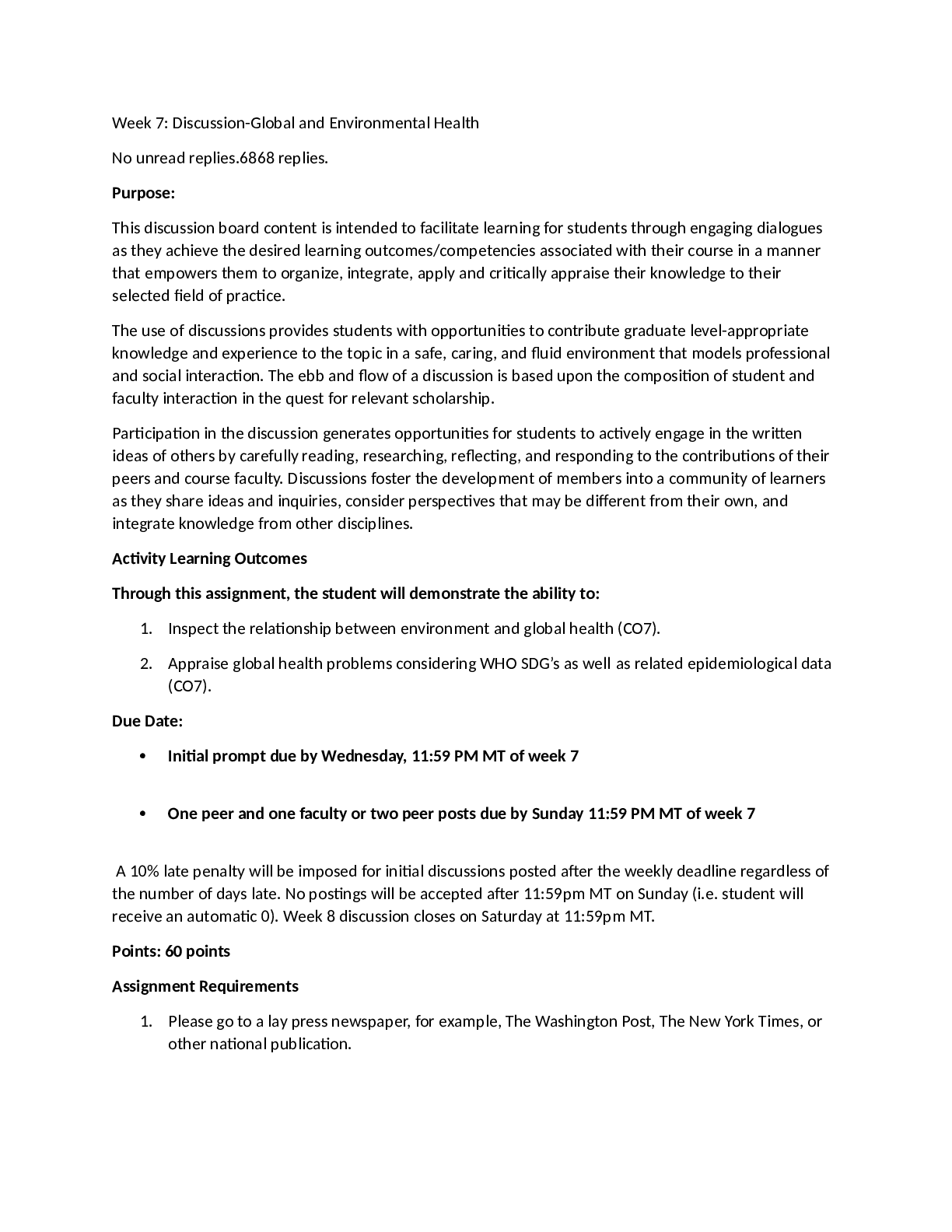


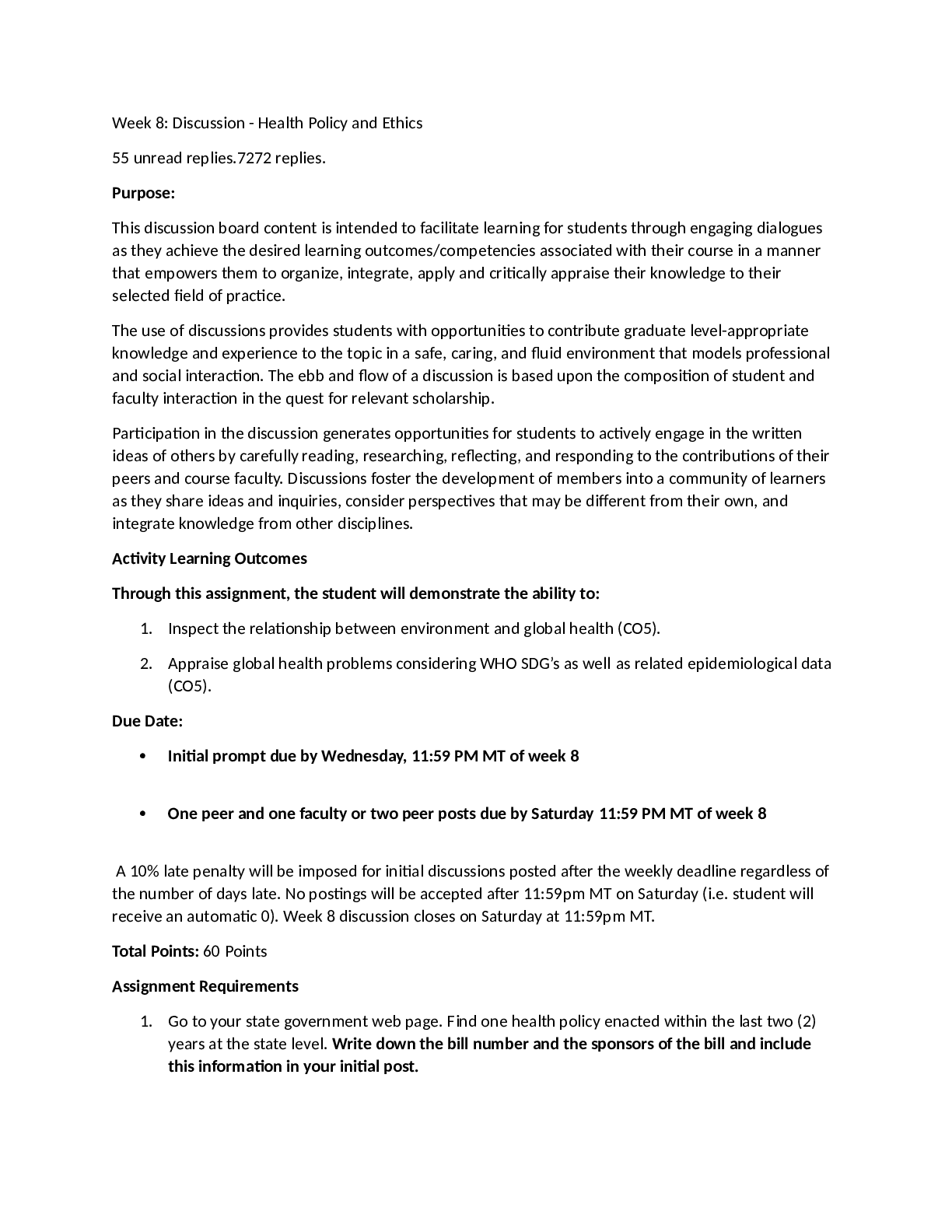

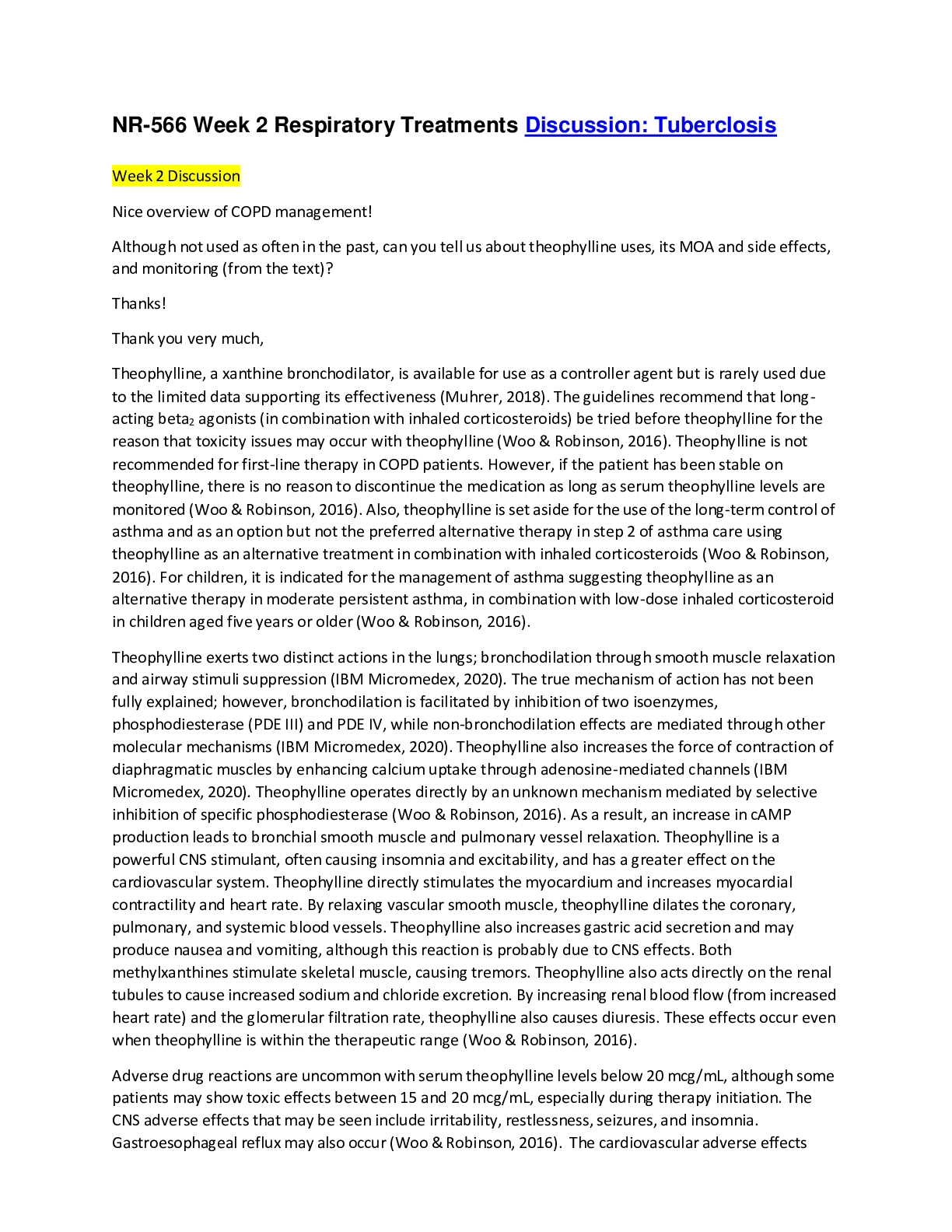
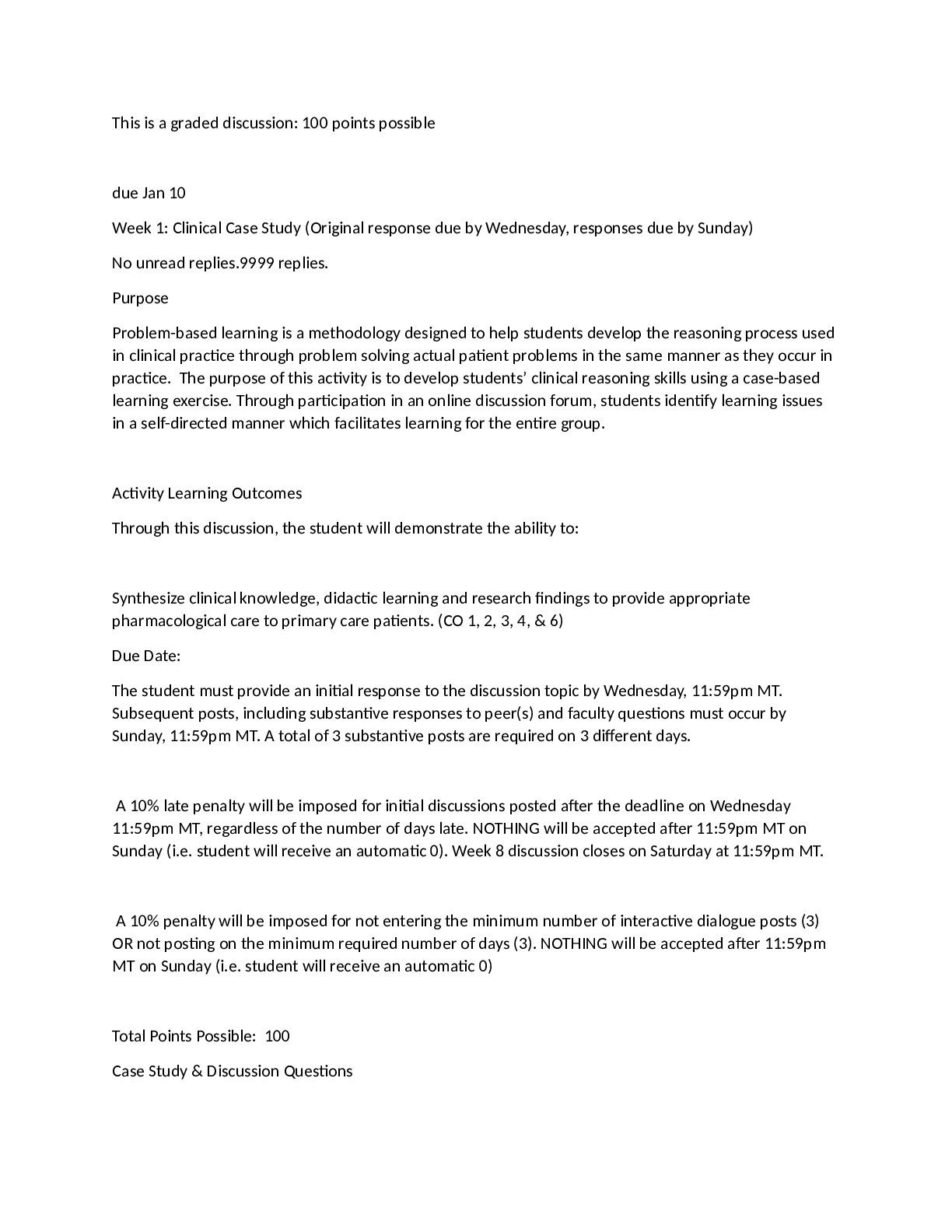



.png)
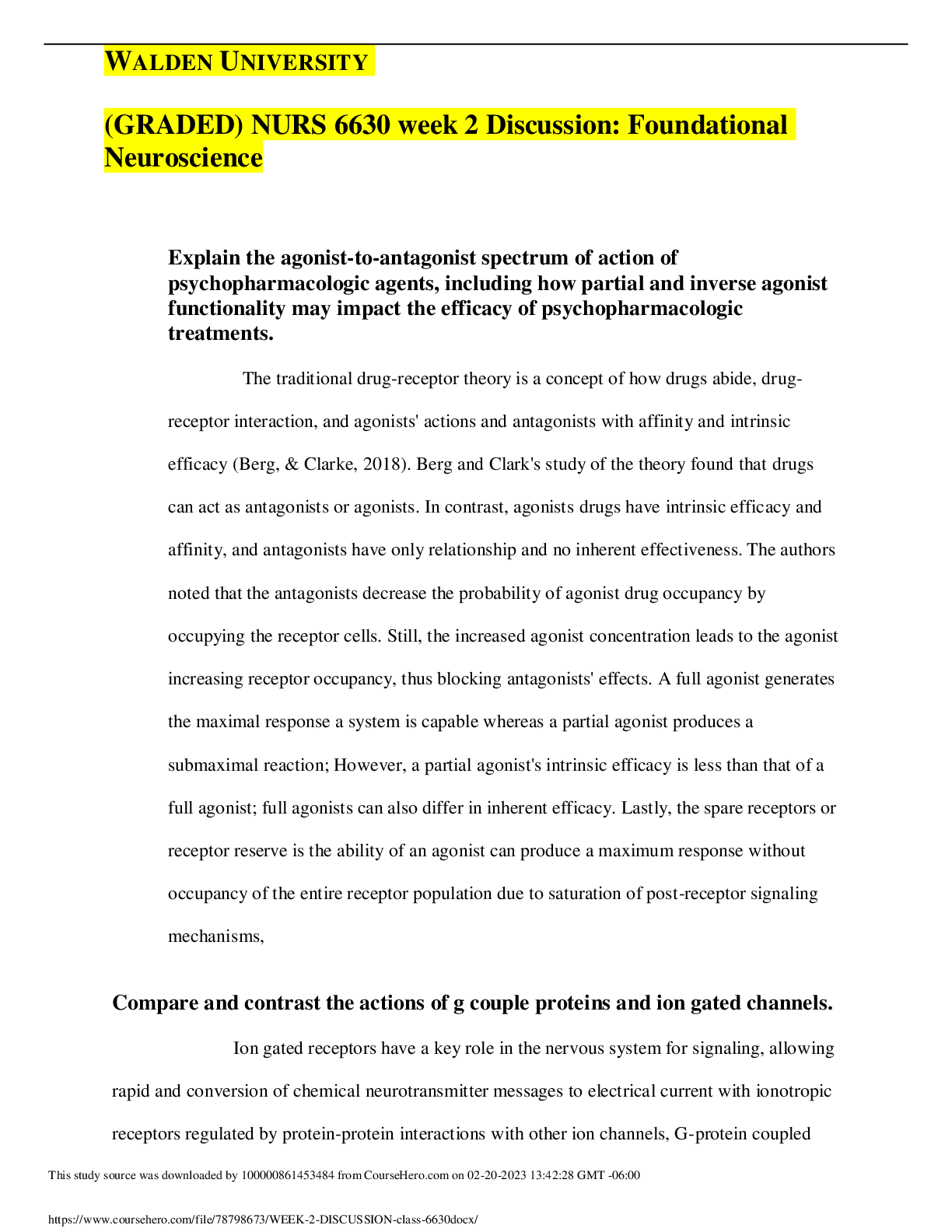
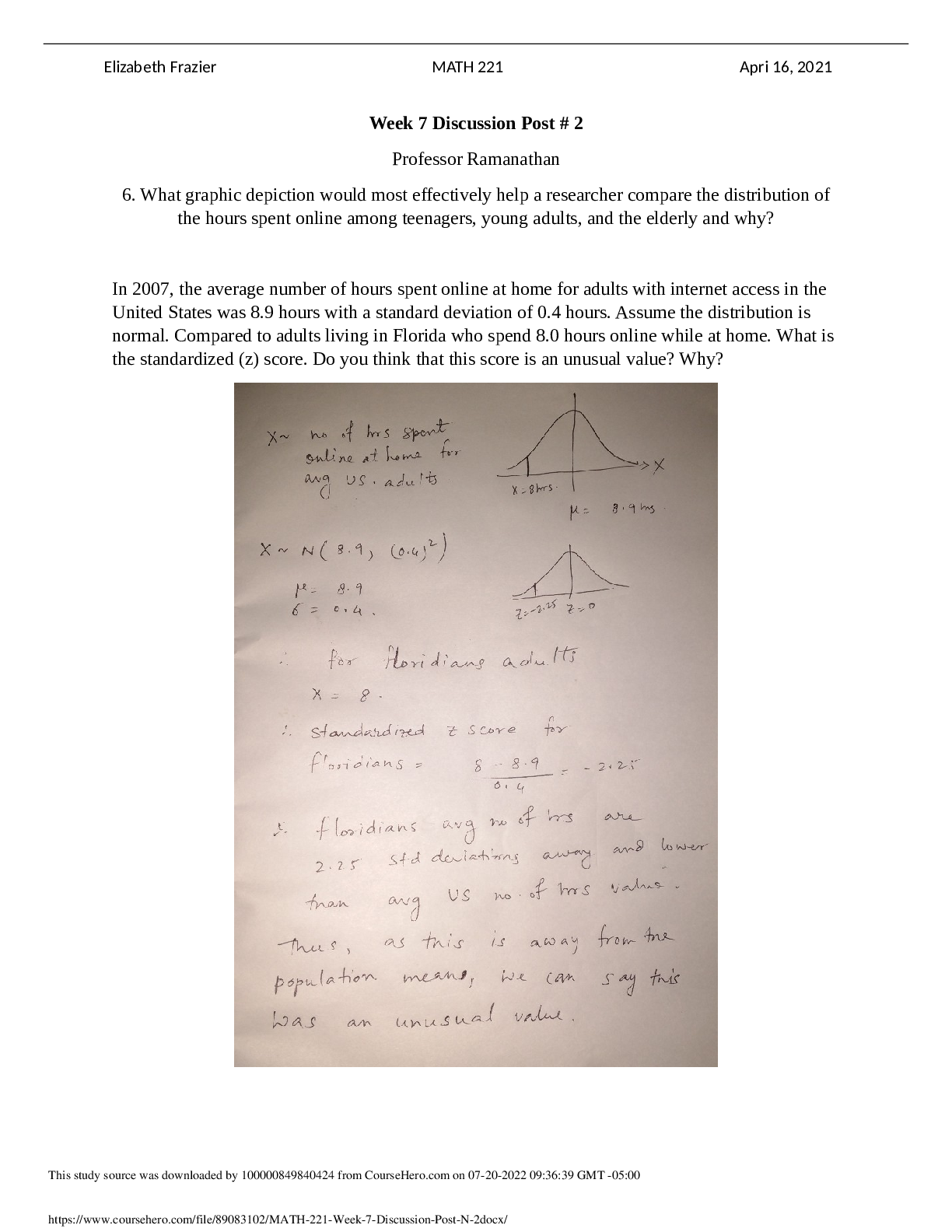
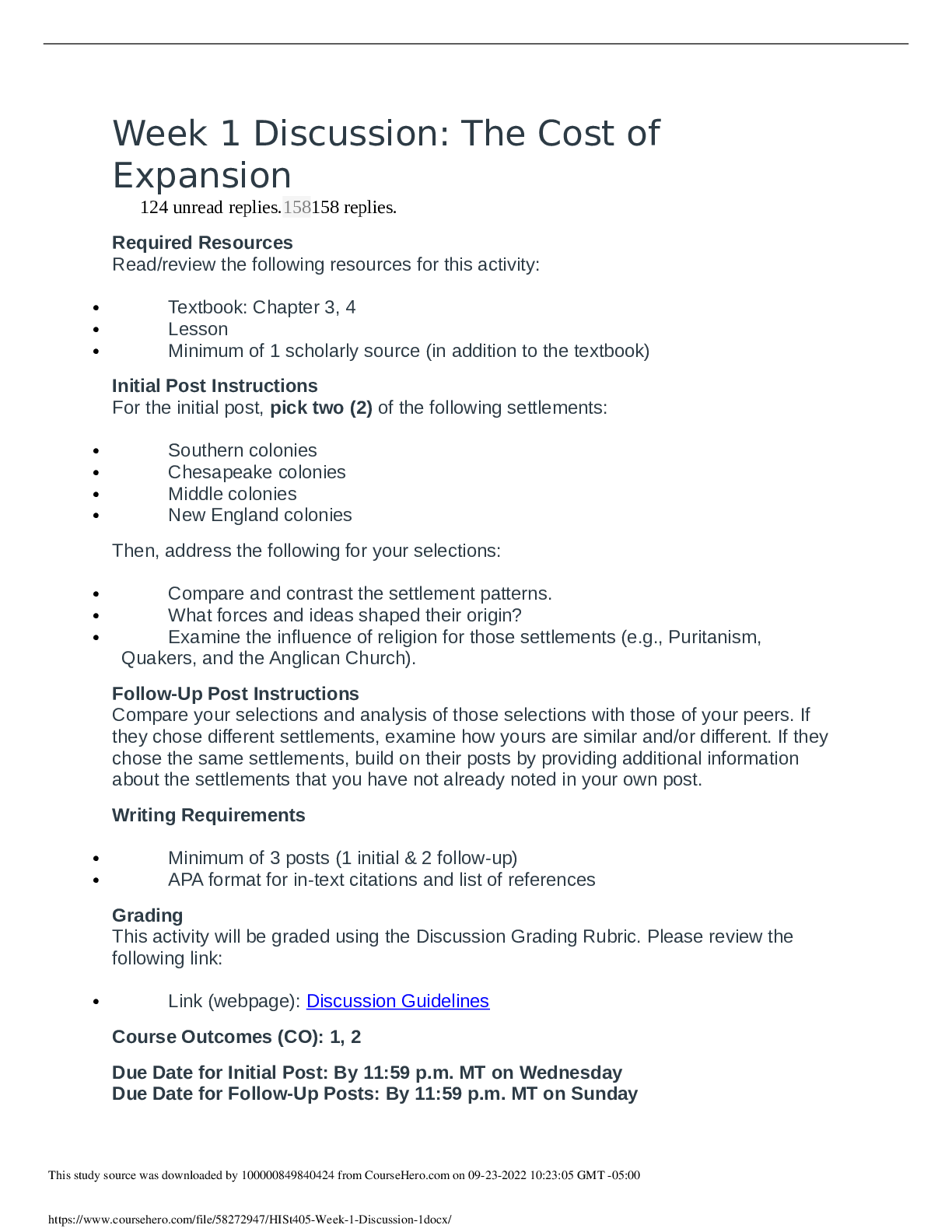



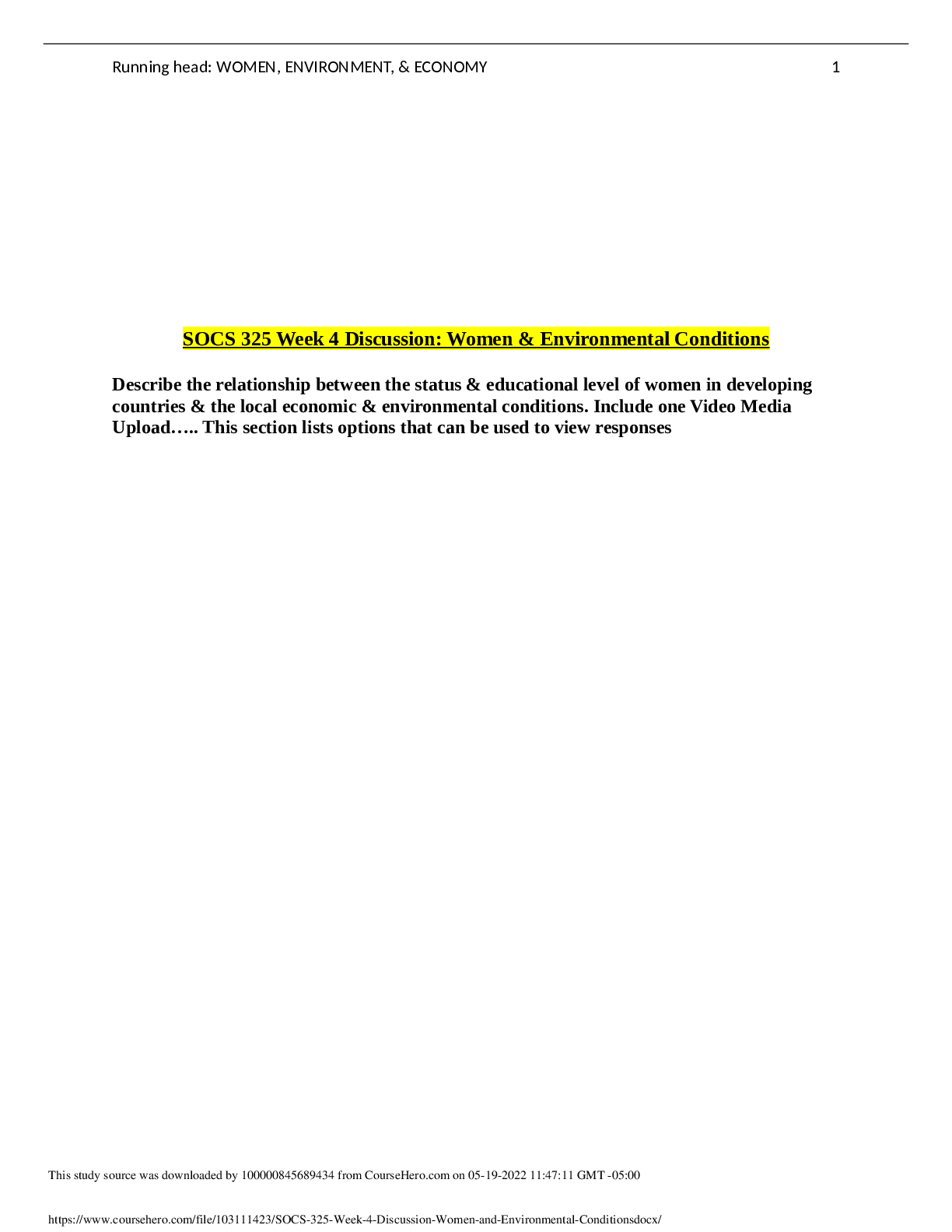

 (1).png)





U.png)
